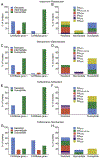Diversity of resistance mechanisms in carbapenem-resistant Enterobacteriaceae at a health care system in Northern California, from 2013 to 2016
- PMID: 30482638
- PMCID: PMC7155946
- DOI: 10.1016/j.diagmicrobio.2018.10.004
Diversity of resistance mechanisms in carbapenem-resistant Enterobacteriaceae at a health care system in Northern California, from 2013 to 2016
Abstract
The mechanism of resistance in carbapenem-resistant Enterobacteriaceae (CRE) has therapeutic implications. We comprehensively characterized emerging mechanisms of resistance in CRE between 2013 and 2016 at a health system in Northern California. A total of 38.7% (24/62) of CRE isolates were carbapenemase gene-positive, comprising 25.0% (6/24) blaOXA-48 like, 20.8% (5/24) blaKPC, 20.8% (5/24) blaNDM, 20.8% (5/24) blaSME, 8.3% (2/24) blaIMP, and 4.2% (1/24) blaVIM. Between carbapenemases and porin loss, the resistance mechanism was identified in 95.2% (59/62) of CRE isolates. Isolates expressing blaKPC were 100% susceptible to ceftazidime-avibactam, meropenem-vaborbactam, and imipenem-relebactam; blaOXA-48 like-positive isolates were 100% susceptible to ceftazidime-avibactam; and metallo β-lactamase-positive isolates were nearly all nonsusceptible to above antibiotics. Carbapenemase gene-negative CRE were 100% (38/38), 92.1% (35/38), 89.5% (34/38), and 31.6% (12/38) susceptible to ceftazidime-avibactam, meropenem-vaborbactam, imipenem-relebactam, and ceftolozane-tazobactam, respectively. None of the CRE strains were identical by whole genome sequencing. At this health system, CRE were mediated by diverse mechanisms with predictable susceptibility to newer β-lactamase inhibitors.
Keywords: Avibactam; Carbapenem-resistant Enterobacteriaceae; Carbapenemase; Porin; Relebactam; Vaborbactam.
Copyright © 2018 Elsevier Inc. All rights reserved.
Conflict of interest statement
Declarations of interest: none.
Figures



Similar articles
-
In vitro activity of meropenem/vaborbactam and characterisation of carbapenem resistance mechanisms among carbapenem-resistant Enterobacteriaceae from the 2015 meropenem/vaborbactam surveillance programme.Int J Antimicrob Agents. 2018 Aug;52(2):144-150. doi: 10.1016/j.ijantimicag.2018.02.021. Epub 2018 Mar 3. Int J Antimicrob Agents. 2018. PMID: 29510189
-
Identifying Spectra of Activity and Therapeutic Niches for Ceftazidime-Avibactam and Imipenem-Relebactam against Carbapenem-Resistant Enterobacteriaceae.Antimicrob Agents Chemother. 2017 Aug 24;61(9):e00642-17. doi: 10.1128/AAC.00642-17. Print 2017 Sep. Antimicrob Agents Chemother. 2017. PMID: 28630202 Free PMC article.
-
Activity of ceftazidime/avibactam, meropenem/vaborbactam and imipenem/relebactam against carbapenemase-negative carbapenem-resistant Enterobacterales isolates from US hospitals.Int J Antimicrob Agents. 2021 Nov;58(5):106439. doi: 10.1016/j.ijantimicag.2021.106439. Epub 2021 Sep 20. Int J Antimicrob Agents. 2021. PMID: 34547421
-
Imipenem-Relebactam and Meropenem-Vaborbactam: Two Novel Carbapenem-β-Lactamase Inhibitor Combinations.Drugs. 2018 Jan;78(1):65-98. doi: 10.1007/s40265-017-0851-9. Drugs. 2018. PMID: 29230684 Review.
-
The rapid spread of carbapenem-resistant Enterobacteriaceae.Drug Resist Updat. 2016 Nov;29:30-46. doi: 10.1016/j.drup.2016.09.002. Epub 2016 Sep 19. Drug Resist Updat. 2016. PMID: 27912842 Free PMC article. Review.
Cited by
-
Molecular Epidemiology of Carbapenemases in Enterobacteriales from Humans, Animals, Food and the Environment.Antibiotics (Basel). 2020 Oct 13;9(10):693. doi: 10.3390/antibiotics9100693. Antibiotics (Basel). 2020. PMID: 33066205 Free PMC article. Review.
-
Clonal Lineages and Virulence Factors of Carbapenem Resistant E. coli in Alameda County, California, 2017-2019.Antibiotics (Basel). 2022 Dec 10;11(12):1794. doi: 10.3390/antibiotics11121794. Antibiotics (Basel). 2022. PMID: 36551451 Free PMC article.
-
Infections Due to Carbapenem-Resistant Bacteria in Patients With Hematologic Malignancies.Front Microbiol. 2020 Jul 17;11:1422. doi: 10.3389/fmicb.2020.01422. eCollection 2020. Front Microbiol. 2020. PMID: 32765433 Free PMC article. Review.
-
#AMRrounds: a systematic educational approach for navigating bench to bedside antimicrobial resistance.JAC Antimicrob Resist. 2023 Aug 14;5(4):dlad097. doi: 10.1093/jacamr/dlad097. eCollection 2023 Aug. JAC Antimicrob Resist. 2023. PMID: 37583473 Free PMC article. Review.
-
New Perspectives on Antimicrobial Agents: Imipenem-Relebactam.Antimicrob Agents Chemother. 2022 Jul 19;66(7):e0025622. doi: 10.1128/aac.00256-22. Epub 2022 Jun 21. Antimicrob Agents Chemother. 2022. PMID: 35727059 Free PMC article. Review.
References
-
- Castanheira M, Huband MD, Mendes RE, Flamm RK. Meropenem–vaborbactam tested against contemporary gram-negative isolates collected worldwide during 2014, including carbapenem-resistant, KPC-producing, multidrug-resistant, and extensively drug-resistant Enterobacteriaceae. Antimicrob Agents Chemother 2017;61:e00567–17. - PMC - PubMed
-
- Clinical and Laboratory Standards institute (CLSI). Performance standards for antimicrobial susceptibility testing: twenty-sixth informational supplement. M100–S26; 2016.
MeSH terms
Substances
Grants and funding
LinkOut - more resources
Full Text Sources
Medical
Miscellaneous

